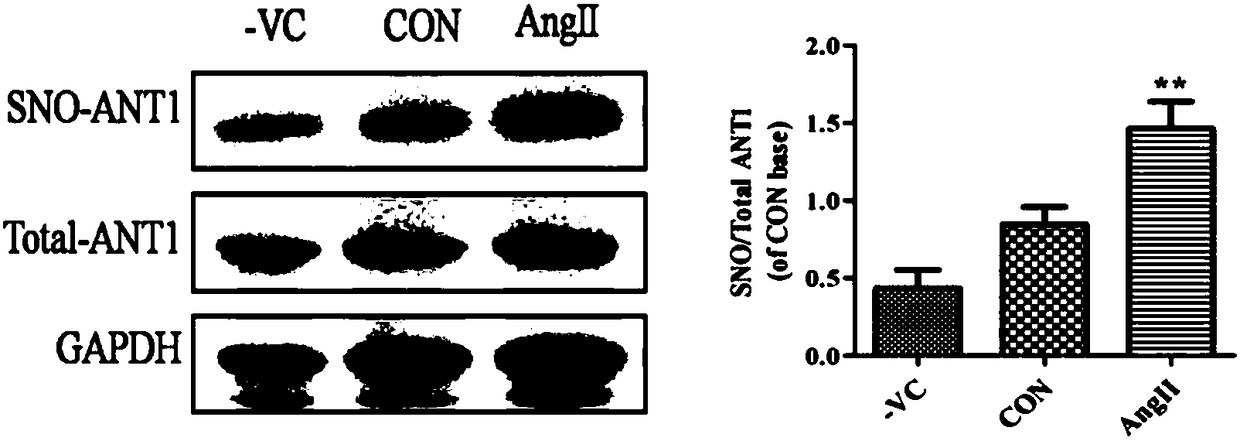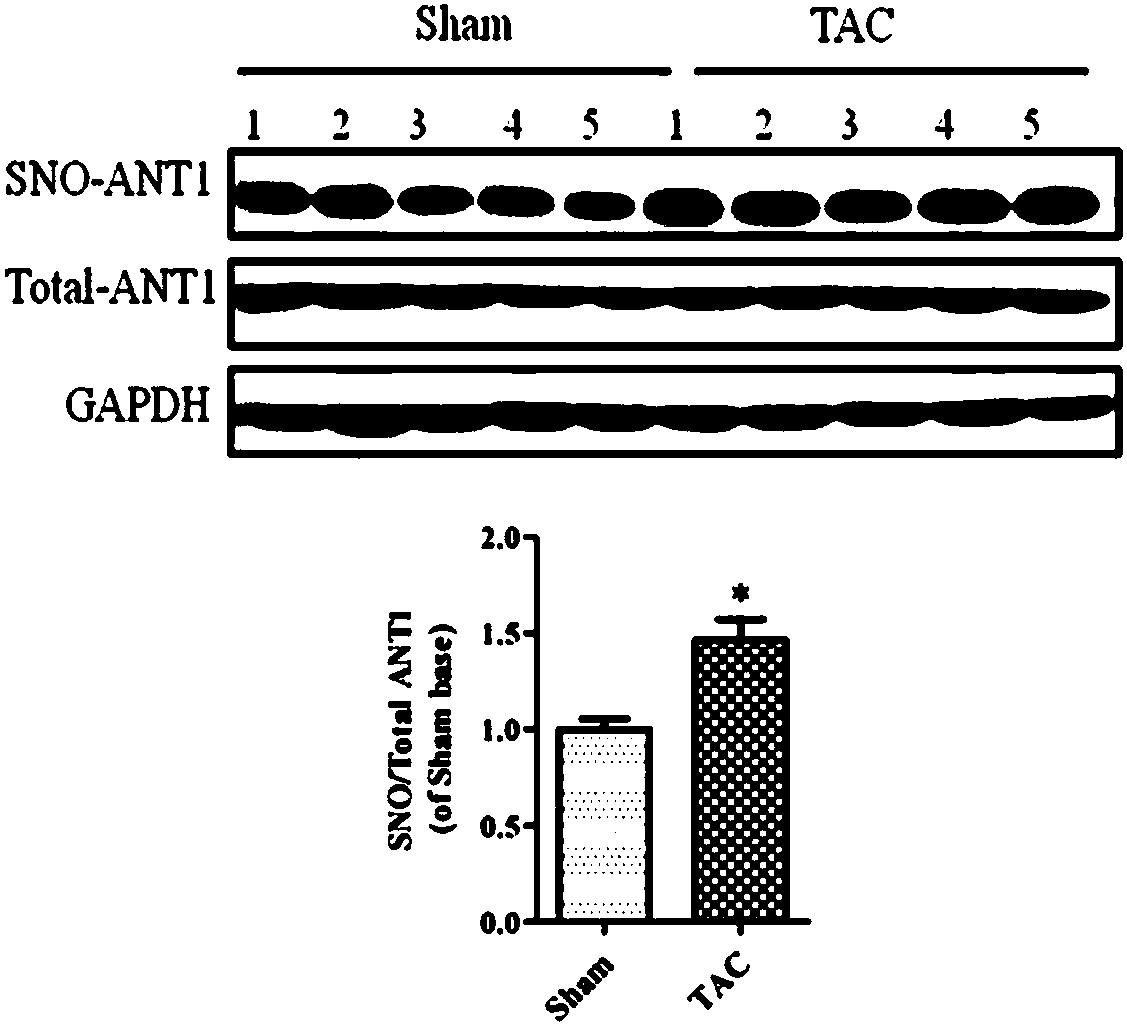Application of adenine nucleotide translocator 1
A technology of adenine nucleotide and transporter is applied in the application field of adenine nucleotide transporter 1 in the field of cardiac hypertrophy treatment to achieve the effect of inhibiting cardiac hypertrophy
- Summary
- Abstract
- Description
- Claims
- Application Information
AI Technical Summary
Problems solved by technology
Method used
Image
Examples
Embodiment 1
[0084]In order to explore the role of thiol-nitrosylation modification of ANT1 protein in cardiac hypertrophy, we cultured primary cardiomyocytes of neonatal rats, stimulated with Ang II (100 nM) for 48 h to induce hypertrophy of cardiomyocytes, compared with normal saline group, Ang II II (100nM) stimulation for 48 h can significantly increase the sulfhydryl nitrosylation level of ANT1 ( figure 1 ). Next, we performed sham surgery (sham) and coarctation of the aorta (TAC) on wild-type C57BL / 6 mice, and extracted sulfhydryl-nitrosylated proteins from myocardial tissue 4 weeks after surgery. The level of thiol-nitrosylation modification of ANT1 protein in mouse myocardial tissue was detected by Biotin-switch. It was found that compared with the control group, the level of thiol-nitrosylation modification of ANT1 protein in the myocardial tissue of mice in the TAC operation group was significantly increased ( figure 2 ). The above experimental results suggest that in the cel...
Embodiment 2
[0086] In order to further clarify the role of thiol-nitrosylation modification of ANT1 protein in cardiac hypertrophy, we combined liquid chromatography tandem mass spectrometry (LC-MS / MS) technology to screen the thiol-nitrosylation modification of ANT1 in SHR and control mice WKY It was found that in SHR heart tissue, the 57th, 129th and 160th cysteine sites (Cys57, Cys129, Cys160) of ANT1 can undergo sulfhydryl nitrosylation modification ( Figure 3A-Figure 3C ). The 57th, 129th and 160th cysteine sites of ANT1 were mutated to alanine (C57A, C129A, C160A) and then transfected into 293T cells, and it was further concluded that the Cys160 site of ANT1 was modified by sulfhydryl nitrosylation ( Figure 4 ). Construct ANT1 wild-type adenovirus (Ad WT), adenovirus with 160th cysteine mutation (AdC160A) and control group adenovirus (Ad GFP) to infect primary cardiomyocytes, give Ang II stimulation, and detect cardiac hypertrophy The expression of related genes ANP and B...
Embodiment 3
[0088] In order to further verify the role of thiol-nitrosylation modification of ANT1 protein in cardiac hypertrophy, we administered 4-week-old C57BL / 6 mice with tail vein injection of heart-specific overexpressed ANT1 wild-type (aav9-ANT1 WT) and ANT1 The adeno-associated virus with cysteine 160 site mutation (aav9-ANT1 C160A) underwent sham and TAC 4 weeks later, and 4 weeks after the operation, the cardiac function and heart-related indicators of the mice were detected by echocardiography, and it was found that after TAC The level of cardiac hypertrophy was significantly increased (IVS-interventricular septal thickness, IVPW-left ventricular posterior wall thickness), and the level of cardiac hypertrophy was significantly reduced after TAC operation with mutation of ANT1 cysteine 160 ( Figure 7 ). Heart tissue was collected to measure heart weight, left ventricle weight, mouse tibia length and other indicators. The results showed that after TAC operation with ANT1 cy...
PUM
 Login to View More
Login to View More Abstract
Description
Claims
Application Information
 Login to View More
Login to View More - R&D
- Intellectual Property
- Life Sciences
- Materials
- Tech Scout
- Unparalleled Data Quality
- Higher Quality Content
- 60% Fewer Hallucinations
Browse by: Latest US Patents, China's latest patents, Technical Efficacy Thesaurus, Application Domain, Technology Topic, Popular Technical Reports.
© 2025 PatSnap. All rights reserved.Legal|Privacy policy|Modern Slavery Act Transparency Statement|Sitemap|About US| Contact US: help@patsnap.com



